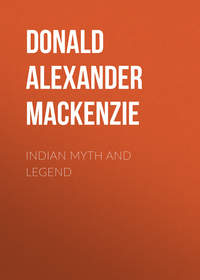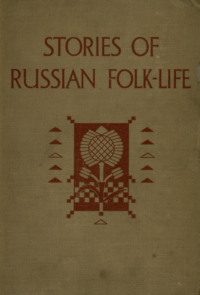 полная версия
полная версияAncient Man in Britain
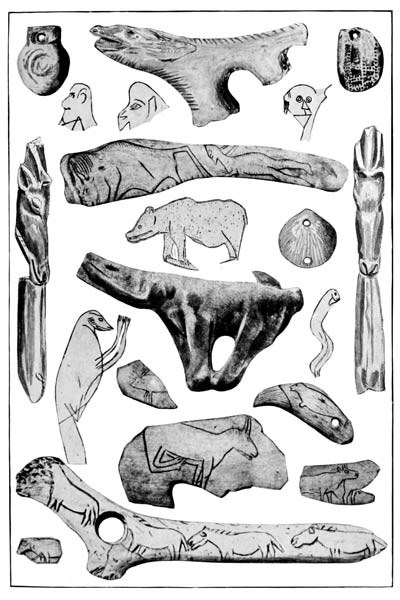
EXAMPLES OF PALÆOLITHIC ART
The objects include: handles of knives and daggers carved in ivory and bone, line drawings of wild animals, faces of masked men, of animal-headed deity or masked man with arms uplifted (compare Egyptian "Ka" attitude of adoration), of wild horses on perforated bâton de commandement, of man stalking a bison, of seal, cow, reindeer, cave-bear, &c., and perforated amulets.
Maglemosian culture is believed to have been introduced by the ancestors of the fair peoples of Northern Europe. It has been so named after the finds at Maglemose in the "Great Moor", near Mullerup, on the western coast of Zeeland. A lake existed at this place at a time when the Baltic was an inland water completely shut off from the North Sea. In a peat bog, formerly the bed of the lake, were found a large number of flint and bone artifacts. These included Tardenoisian microliths, barbed harpoons of bone, needles of bone, spears of bone, &c. Bone was more freely used than horn for implements and weapons. The animals hunted included the stag, roe-deer, moose, wild ox, and wild boar. Dogs were domesticated. It appears that the Maglemosians were lake-dwellers. Their houses, however, had not been erected on stilts, but apparently on a floating platform of logs, which was no doubt anchored or moored to the shore. There are traces of Magdalenian influence in Maglemosian culture. Although many decorative forms on bone implements and engravings on rocks are formal and symbolic, there are some fine and realistic representations of animals worthy of the Magdalenian cave artists. Traces of the Maglemosian racial drift have been obtained on both sides of the Baltic and in the Danish kitchen middens. Engravings on rocks at Lake Onega in Northern Russia closely resemble typical Maglemosian work. Apparently the northern fair peoples entered Europe from Western Siberia, and in time were influenced by Neolithic culture. But before the Europeans began to polish their stone implements and weapons, the blond hunters and fishermen settled not only in Denmark and Southern Sweden and Norway but also in Britain.
At the time when the Baltic was an inland fresh-water lake, the southern part of the North Sea was dry land, and trees grew on Dogger Bank, from which fishermen still occasionally lift in their trawls lumps of "moor-log" (peat) and the bones of animals, including those of the reindeer, the red deer, the horse, the wild ox, the bison, the Irish elk, the bear, the wolf, the beaver, the woolly rhinoceros, the mammoth, and the walrus. No doubt the Maglemosians found their way over this "land-bridge", crossing the rivers in rude boats, and on foot when the rivers were frozen. Evidence has been forthcoming that they also followed the present coast line towards Boulogne, near which a typical Maglemosian harpoon has been discovered.
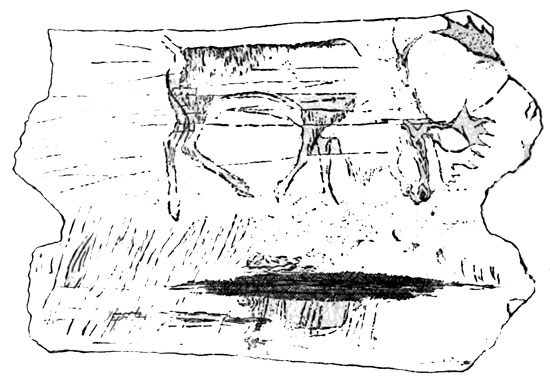
A Notable Example of late Magdalenian Culture: engraving on bone of browsing reindeer. From Kesserloch, Switzerland. (After Heim.)
Traces of Maglemosian influence have been found as far north as Scotland on the Hebridean islands of Oronsay and Risga. The MacArthur cave at Oban reveals Azilian artifacts. In the Victoria cave near Settle in Yorkshire a late Magdalenian or proto-Azilian harpoon made of reindeer-horn is of special interest, displaying, as it does, a close connection between late Magdalenian and early Azilian. Barbed harpoons, found at the shelter of Druimvargie, near Oban, are Azilian, some displaying Maglemosian features. Barbed harpoons of bone, and especially those with barbs on one side only, are generally Maglemosian, while those of horn and double-barbed are typically Azilian.
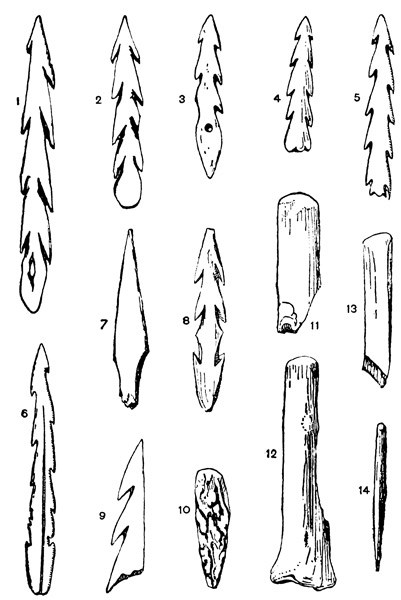
Horn and Bone Implements
Harpoons: 1 and 2, from MacArthur Cave, Oban; 3, from Laugerie Basse rock-shelter, France; 4, from shell-heap, Oronsay, Hebrides; 5, from bed of River Dee near Kirkcudbright; 6, from Palude Brabbie, Italy—all of Azilian type. 8, Reindeer-horn harpoon of late Magdalenian, or proto-Azilian, type from Victoria Cave, near Settle, Yorks. 9, Maglemosian, or Azilian-Maglemosian, harpoon from rock-shelter, Druimvargie, Oban. 7, 10, 11, 12, 13, and 14, bone and deer-horn implements from MacArthur Cave, Oban.
Apparently the fair Northerners, the carriers of Maglemosian culture, and the dark Iberians, the carriers of Azilian culture, met and mingled in Scotland and England long before the Neolithic industry was introduced. There were also, it would appear, communities in Britain of Crô-Magnons, and perhaps of other racial types that existed on the Continent and in late Magdalenian times. The fair peoples of England and Wales, Scotland and Ireland are not therefore all necessarily descendants of Celts, Angles, Saxons, and Vikings. The pioneer settlers in the British Isles, in all probability, included blue and grey-eyed and fair or reddish-haired peoples who in Scotland may have formed the basis of the later Caledonian type, compared by Tacitus to the Germans, but bearing an undoubted Celtic racial name, the military aristocrats being Celts.41
CHAPTER VI
The Faithful Dog
Transition Period between Palæolithic and Neolithic Ages—Theory of the Neolithic Edge—Crô-Magnon Civilization was broken up by Users of Bow and Arrow—Domesticated Dog of Fair Northerners—Dogs as Guides and Protectors of Man—The Dog in Early Religion—Dog Guides of Souls—The Dog of Hades—Dogs and Death—The Scape-dog in Scotland—Souls in Dog Form—Traces of Early Domesticated Dogs—Romans imported British Dogs.
The period we have now reached is regarded by some as that of transition between the Palæolithic and Neolithic Ages, and by others as the Early Neolithic period. It is necessary, therefore, that we should keep in mind that these terms have been to a great extent divested of the significance originally attached to them. The transition period was a lengthy one, extending over many centuries during which great changes occurred. It was much longer than the so-called "Neolithic Age". New races appeared in Europe and introduced new habits of life and thought, new animals appeared and animals formerly hunted by man retreated northward or became extinct; the land sank and rose; a great part of the North Sea and the English Channel was for a time dry land, and trees grew on the plateau now marked by the Dogger Bank during this "Transition Period", and before it had ended the Strait of Dover had widened and England was completely cut off from the Continent.
Compared with these great changes the invention of the polished axe edge seems almost trivial. Yet some writers have regarded this change as being all-important. "On the edge ever since its discovery", writes one of them with enthusiasm, "has depended and probably will depend to the end of time the whole artistic and artificial environment of human existence, in all its infinite varied complexity.... By this discovery was broken down a wall that for untold ages had dammed up a stagnant, unprogressive past, and through the breach were let loose all the potentialities of the future civilization of mankind. It was entirely due to the discovery of the edge that man was enabled, in the course of time, to invent the art of shipbuilding."42
This is a very sweeping claim and hardly justified by the evidence that of late years has come to light. Much progress had been achieved before the easy method of polishing supplanted that of secondary working. The so-called Palæolithic implements were not devoid of edges. What really happened was that flint-working was greatly simplified. The discovery was an important one, but it was not due to it alone that great changes in habits of life were introduced. Long before the introduction of the Neolithic industry, the earliest traces of which in Western Europe have been obtained at Campigny near the village of Blangy on the River Bresle, the Magdalenian civilization of the Crô-Magnons had been broken up by the Azilian-Tardenoisian intruders in Central and Western Europe and by the Maglemosians in the Baltic area.
The invading hordes in Spain, so far as can be gathered from rock pictures, made more use of bows and arrows than of spears, and it may be that their social organization was superior to that of the Magdalenians. Their animal "drives" suggest as much. It may be that they were better equipped for organized warfare—if there was warfare—and for hunting by organizing drives than the taller and stronger Crô-Magnons. When they reached the Magdalenian stations they adopted the barbed harpoon, imitating reindeer-horn forms in red-deer horn.
The blond Maglemosians in the Baltic area introduced from Asia the domesticated dog. They were thus able to obtain their food supply with greater ease than did the Solutreans with their laurel-leaf lances, or the Magdalenians with their spears tipped with bone or horn. When man was joined by his faithful ally he met with more success than when he pursued the chase unaided. Withal, he could take greater risks when threatened by the angry bulls of a herd, and operate over more extended tracks of country with less fear of attack by beasts of prey. His dogs warned him of approaching peril and guarded his camp by night.
Hunters who dwelt in caves may have done so partly for protection against lions and bears and wolves that were attracted to hunters' camps by the scent of flesh and blood. No doubt barriers had to be erected to shield men, women, and children in the darkness; and it may be that there were fires and sentinels at cave entrances.
The introduction of the domesticated dog may have influenced the development of religious beliefs. Crô-Magnon hunters appear to have performed ceremonies in the depths of caverns where they painted and carved wild animals, with purpose to obtain power over them. Their masked dances, in which men and women represented wild animals, chiefly beasts of prey, may have had a similar significance. The fact that, during the Transition Period, a cult art passed out of existence, and the caves were no longer centres of culture and political power, may have been directly or indirectly due to the domestication of the dog and the supremacy achieved by the intruders who possessed it.
There can be no doubt that the dog played its part in the development of civilization. As much is suggested by the lore attaching to this animal. It occupies a prominent place in mythology. The dog which guided and protected the hunter in his wanderings was supposed to guide his soul to the other world.
He thought admitted to that equal sky,His faithful dog would bear him company.In Ancient Egypt the dog-headed god Anubis was the guide and protector of souls. Apuatua, an early form of Osiris, was a dog god. Yama, the Hindu god of death, as Dharma, god of justice, assumed his dog form to guide the Panadava brothers to Paradise, as is related in the Sanskrit epic the Mahá-bhárata43. The god Indra, the Hindu Jupiter, was the "big dog", and the custom still prevails among primitive Indian peoples of torturing a dog by pouring hot oil into its ears so that the "big dog" may hear and send rain. In the Mahá-bhárata there is a story about Indra appearing as a hunter followed by a pack of dogs. As the "Wild Huntsman" the Scandinavian god Odin rides through the air followed by dogs. The dog is in Greek mythology the sentinel of Hades; it figures in a like capacity in the Hades of Northern Mythology. Cuchullin, the Gaelic hero, kills the dog of Hades and takes its place until another dog is found and trained, and that is why he is called "Cu" (the dog) of Culann. A pool in Kildonan, Sutherland, which was reputed to contain a pot of gold, was supposed to be guarded by a big black dog with two heads. A similar legend attaches to Hound's Pool in the parish of Dean Combe, Devonshire. In different parts of the world the dog is the creator and ancestor of the human race, the symbol of kinship, &c. The star Sirius was associated with the dog. In Scotland and Ireland "dog stones" were venerated. A common surviving belief is that dogs howl by night when a sudden death is about to occur. This association of the dog with death is echoed by Theocritus. "Hark!" cries Simaetha, "the dogs are barking through the town. Hecate is at the crossways. Haste, clash the brazen cymbals." The dog-god of Scotland is remembered as an cù sìth ("the supernatural dog"); it is as big as a calf, and by night passes rapidly over land and sea. A black demon-dog—the "Moddey Dhoo"—referred to by Scott in Peveril of the Peak was supposed to haunt Peel Castle in the Isle of Man. A former New Year's day custom in Perthshire was to send away from a house door a scape-dog with the words, "Get away you dog! Whatever death of men or loss of cattle would happen in this house till the end of the present year, may it all light on your head." A similar custom obtained among Western Himalayan peoples. Early man appears to have regarded his faithful companion as a supernatural being. There are Gaelic references to souls appearing in dog form to assist families in time of need. Not only did the dog attack beasts of prey; in Gaelic folk-tales it is the enemy of fairies and demons, and especially cave-haunting demons. Early man's gratitude to and dependence on the dog seems to be reflected in stories of this kind.
When the Baltic peoples, who are believed to be the first "wave" of blond Northerners, moved westward towards Denmark during the period of the "great thaw", they must have been greatly assisted by the domesticated dog, traces of which are found in Maglemosian stations. Bones of dogs have been found in the Danish kitchen middens and in the MacArthur cave at Oban. It may be that the famous breed of British hunting dogs which were in Roman times exported to Italy were descended from those introduced by the Maglemosian hunters. Seven Irish dogs were in the fourth century presented to Symmachus, a Roman consul, by his brother. "All Rome", the grateful recipient wrote, "view them with wonder and thought they must have been brought hither in iron cages."
Great dogs were kept in Ancient Britain and Ireland for protection against wolves as well as for hunting wild animals. The ancient Irish made free use in battle of large fierce hounds. In the folk-stories of Scotland dogs help human beings to attack and overcome supernatural beings. Dogs were the enemies of the fairies, mermaids, &c.
Dog gods figure on the ancient sculptured stones of Scotland. The names of the Irish heroes Cuchullin and Con-chobar were derived from those of dog deities. "Con" is the genitive of "Cu" (dog).
CHAPTER VII
Ancient Mariners Reach Britain
Reindeer in Scotland—North Sea and English Channel Land-bridges—Early River Rafts and River Boats—Breaking of Land-bridges—Coast Erosion—Tilbury Man—Where were first Boats Invented?—Ancient Boats in Britain—"Dug-out" Canoes—Imitations of Earlier Papyri and Skin Boats—Cork Plug in Ancient Clyde Boat—Early Swedish Boats—An African Link—Various Types of British Boats—Daring Ancient Mariners—The Veneti Seafarers—Attractions of Early Britain for Colonists.
The Maglemosian (Baltic) and Azilian (Iberian) peoples, who reached and settled in Britain long before the introduction of the Neolithic industry, appear, as has been shown, to have crossed the great land-bridge, which is now marked by the Dogger Bank, and the narrowed land-bridge that connected England and France. No doubt they came at first in small bands, wandering along the river banks and founding fishing communities, following the herds of red deer and wild cows that had moved northward, and seeking flints, &c. The Crô-Magnons, whose civilization the new intruders had broken up on the Continent, were already in Britain, where the reindeer lingered for many centuries after they had vanished from France. The reindeer moss still grows in the north of Scotland. Bones and horns of the reindeer have been found in this area in association with human remains as late as of the Roman period. In the twelfth century the Norsemen hunted reindeer in Caithness.44 Cæsar refers to the reindeer in the Hercynian forest of Germany (Gallic War, VI, 26).
The early colonists of fair Northerners who introduced the Maglemosian culture into Britain from the Baltic area could not have crossed the North Sea land-bridge without the aid of rafts or boats. Great broad rivers were flowing towards the north. The Elbe and the Weser joined one another near the island of Heligoland, and received tributaries from marshy valleys until a long estuary wider than is the Wash at present was formed. Another long river flowed northward from the valley of the Zuyder Zee, the mouth of which has been traced on the north-east of the Dogger Bank. The Rhine reached the North Sea on the south-west of the Dogger Bank, off Flamborough Head; its tributaries included the Meuse and the Thames. The Humber and the rivers flowing at present into the Wash were united before entering the North Sea between the mouth of the Rhine and the coast of East Riding.
The Dogger Bank was then a plateau. Trawlers, as has been stated, sometimes lift from its surface in their trawl nets lumps of peat, which they call "moor-log", and also the bones of wild animals, including the wild ox, the wild horse, red deer, reindeer, the elk, the bear, the wolf, the hyæna, the beaver, the walrus, the woolly rhinoceros, and the hairy mammoth. In the peat have been found the remains of the white birch, the hazel, sallow, and willow, seeds of bog-bean, fragments of fern, &c. All the plants have a northern range. In some pieces of peat have been found plants and insects that still flourish in Britain.45
The easiest crossing to Britain was over the English Channel land-bridge. It was ultimately cut through by the English Channel river, so that the dark Azilian-Tardenoisian peoples from Central and Western Europe and the fair Maglemosians must have required and used rafts or boats before polished implements of Neolithic type came into use. In time the North Sea broke through the marshes of the river land to the east of the Thames Estuary and joined the waters of the English Channel. The Strait of Dover was then formed. At first it may have been narrow enough for animals to swim across or, at any rate, for the rude river boats or rafts of the early colonists to be paddled over in safety between tides. Gradually, however, the strait grew wider and wider; the chalk cliffs, long undermined by boring molluscs and scouring shingle, were torn down by great billows during winter storms.
It may be that for a long period after the North Sea and English Channel were united, the Dogger Bank remained an island, and that there were other islands between Heligoland and the English coast. Pliny, who had served with the Roman army in Germany, writing in the first century of our era, refers to twenty-three islands between the Texel and the Eider in Schleswig-Holstein. Seven of these have since vanished. The west coast of Schleswig has, during the past eighteen hundred years, suffered greatly from erosion, and alluvial plains that formerly yielded rich harvests are now represented by sandbanks. The Goodwin Sands, which stretch for about ten miles off the Kentish coast, were once part of the fertile estate of Earl Godwin which was destroyed and engulfed by a great storm towards the end of the eleventh century. The Gulf of Zuyder Zee was formerly a green plain with many towns and villages. Periodic inundations since the Roman period have destroyed flourishing Dutch farms and villages and eaten far into the land. There are records of storm-floods that drowned on one occasion 20,000, and on another no fewer than 100,000 inhabitants.46 It is believed that large tracts of land, the remnants of the ancient North Sea land-bridge, have been engulfed since about 3000 b.c., as a result not merely of erosion but the gradual submergence of the land. This date is suggested by Mr. Clement Reid.
"The estimate", he says, "may have to be modified as we obtain better evidence; but it is as well to realize clearly that we are not dealing with a long period of great geological antiquity; we are dealing with times when the Egyptian, Babylonian, and Minoan (Cretan) civilizations flourished. Northern Europe was then probably barbarous, and metals had not come into use;47 but the amber trade of the Baltic was probably in full swing. Rumours of any great disaster, such as the submergence of thousands of square miles and the displacement of large populations, might spread far and wide along the trade routes." It may be that the legend of the Lost Atlantis was founded on reports of such a disaster, that must have occurred when areas like the Dogger Bank were engulfed. It may be too that the gradual wasting away of lands that have long since vanished propelled migrations of peoples towards the smiling coasts of England. According to Ammianus the Druids stated that some of the inhabitants of Gaul were descendants of refugees from sea-invaded areas.
The gradual sinking of the land and the process of coast erosion has greatly altered the geography of England. The beach on which Julius Cæsar landed has long since vanished, the dwellings of the ancient Azilian and Maglemosian colonists, who reached England in post-Glacial times, have been sunk below the English Channel. When Tilbury Docks were being excavated Roman remains were found embedded in clay several feet below high-water mark. Below several layers of peat and mud, and immediately under a bank of sand in which were fragments of decomposed wood, was found the human skeleton known as "Tilbury man". The land in this area was originally 80 feet above its present level.48 But while England was sinking Scotland was rising. The MacArthur cave at Oban, in which Azilian hunters and fishermen made their home on the sea-beach, is now about 30 feet above the old sea-level.
Before Dover Strait had been widened by the gradual sinking of the land and the process of coast erosion, and before the great islands had vanished from the southern part of the North Sea, the early hunters and fishermen could have experienced no great difficulty in reaching England. It is possible that the Azilian, Tardenoisian, and Maglemosian peoples had made considerable progress in the art of navigation. Traces of the Tardenoisian industry have been obtained in Northern Egypt, along the ancient Libyan coast of North Africa where a great deal of land has been submerged, and especially at Tunis, and in Algiers, in Italy, and in England and Scotland, as has been noted. There were boats on the Mediterranean at a very early period. The island of Crete was reached long before the introduction of copper-working by seafarers who visited the island of Melos, and there obtained obsidian (natural glass) from which sharp implements were fashioned. Egyptian mariners, who dwelt on the Delta coast, imported cedar, not only from Lebanon but from Morocco, as has been found from the evidence afforded by mummies packed with the sawdust of cedar from the Atlas Mountains.49 When this trade with Morocco began it is impossible to say with certainty. Long before 3000 b.c., however, the Egyptians were building boats that were fitted with masts and sails. The ancient mariners were active as explorers and traders before implements of copper came into use.
Here we touch on a very interesting problem. Where were boats first invented and the art of navigation developed? Rafts and floats formed by tying together two trees or, as in Egypt, two bundles of reeds, were in use at a very early period in various countries. In Babylonia the "kufa", a great floating basket made watertight with pitch or covered with skins, was an early invention. It was used as it still is for river ferry boats. But ships were not developed from "kufas". The dug-out canoe is one of the early prototypes of the modern ocean-going vessel. It reached this country before the Neolithic industry was introduced, and during that period when England was slowly sinking and Scotland was gradually rising. Dug-out canoes continued to come during the so-called "Neolithic" stage of culture ere yet the sinking and rising of land had ceased. "That Neolithic man lived in Scotland during the formation of this beach (the 45-to 50-foot beach) is proved", wrote the late Professor James Geikie, "by the frequent occurrence in it of his relics. At Perth, for example, a dug-out canoe of pine was met with towards the bottom of the carse clays; and similar finds have frequently been recorded from the contemporaneous deposits in the valleys of the Forth and the Clyde."50





